R .DAHAL’SPROSPEROLOGY (A System of Human Activity) Content 1.To Human Being 2.Human Desire 3.Earning and Time Value 4.Prosperity 5.Prosperity Desire 6.Prosperity and Equality 7.Poverty Line or Poverty Threshold 8.Production 9.Saving, Investment and Capital 10.Time Line Prosperity and Development 11.Capital and ExploitationPart I PROSPERITY DESIRE (The Driving Force of human Development)
home prosperity desire pricniples of prosperity prosperity in Practice
1. To Human Being
I have no reason to believe the religious doctrine of creation and so I have to follow the Darwinian Theory of Evolution. As we find coral-like semi- living or semi-nonliving animals or materials even now, they provide justification to believe in creation of animal from material by evolution, though the first creature should be lowly one-cell one. No doubt those creatures received all their nourishment from one source to make their life easy. To avoid the tedious path of changing from non-living to living, time and again, the one-cell creature learned to divide itself in two and further. Sexual generation was not yet evolved. As the one-cell creature evolved to multi-cell one, source of nourishment became diverse and so started a harsh competition for food, water and mate. Nature freely provided the animals what they needed and they were adjusted to and satisfied of what nature provided them or had to die out. Natural evolution had no other option.
Evolution of human being created a new dimension in the law of nature. While earlier creatures were limited to natural needs, human fascinated a new luxury called desire. Only very highly developed mind could afford such luxury.
Thus, came the difference between human and other animals. Human learnt to act and to venture to fulfill his desire. Thus, by dictate of evolution a semi-living creature was converted to a desiring animal and he dominated the earth and, at times, defied the nature too .
Animals need to consume to survive and higher the animal species, higher is the sphere of consumption. The minimum needs for physical survival are basic animal needs and consumption or consumables beyond basic needs are desire. Only human being has a sense of desire and its highest form of desire is prosperity increment desire or prosperity desire.
Animal needs are basic but some of the human needs are optional.
1. Air
2. Water
3. Food
4. Mating
5. Shelter
6. Clothing
7. Other needs as per social status
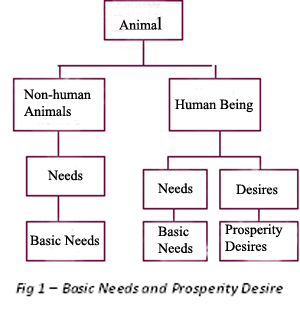
The first three are basic needs of animal survival and their priority decreases down from air to food. Mating is not an absolute need for survival of an individual but it is natural necessity for regeneration. Shelter is taken some times by other animals if available but below than that are created by human desire. In modern days of civilization, commodities created by human desire can be taken as basic needs of survival in that very civilization.
2. Human Desire
After all, what is desire that boosts human activities? What is the difference between human need and desire?
Living beings need something basic to sustain their life and to continue their activities. Every living being labours to acquire these items in daily basis and is satisfied if it gets them but human being wants something more than his basic need. Such want beyond the natural requirement is called desire. While human need is essential for his survival, desire is just string longing for satisfaction and happiness or for something beyond natural need. Desire may vary from time to time, place to place and person to person. A person without desire is a hermit living in the wild, who has neither plan nor better expectations.
Desire motivates a person to have more and activates him to gain it. A tallest giraffe cannot grab the leaves above its height. Two bulls can hit or push hard each other by what their strength provides. Even the fastest cheetah has limit in its speed but human has no such limits. He uses stairs, cranes, and lifts to raise himself above his height, uses bicycles, vehicles, horses, airplanes to gain speed and wrestles cunningly bare hand or uses tools to overcome his opponent. The superb brain acts both positively and negatively to fulfill his desire. Capacity or strength of other animals can be measured in power units but that of human cannot be done so. Other animals have measurable physical strength but mental creativity of human is un-measurable. And so is desire.
Fulfillment of one desire creates another and so on. Desire creates capacity, capacity fulfils action, action creates gain and gain brings satisfaction and raises affluence level where another desire rises automatically. This never ending circle of human activity moves like a spiral upward, raising human knowledge and affluence. Thus, human civilization is a creation of revolving activity of desire.
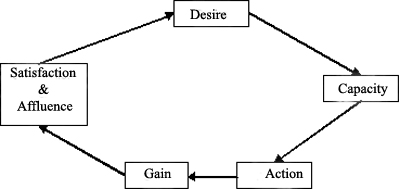
Fig 2 - Desire Cycle
‘Necessity is mother of invention’ – says a proverb but what a person needs if he is satisfied on what he has. Desire creates dissatisfaction or vice versa. A person desires to be better than or superior to others. Even a breadwinner demands loyalty or respect from family members. He desires superiority, efforts for it and gets it to earn respect and superiority. Thus we come to conclusion: animal needs are natural necessities for survival of the self and desires are human necessities for prosperity.
3. Earning and Time Value
Wild animals do not work and they live on what they get in wild. Domestic animals do not earn too. They are fed by their masters. Children, old and sick people are parasitic sub-ordinates to their breadwinners. A person has to earn some thing for his own and for his sub-ordinates’ survival.
Earning of a person is consumable equivalent available to him within a time unit against his physical and mental work and that depends upon output of his work and upon his working situation and surroundings. Only working person earns something. Non-working persons live either on accumulated earning or as parasites on others’ earnings. But time value of a person is sum of consumables accessible to a person from all sources in a unit time. People may live without earning but they cannot do so without time value. Human being with zero time value is a dead person. So, time value of a person or personal time value is an accessible amount of consumables of a person within a unit time. In other words, time value is an amount of consumables (materials and services) available from different sources accessible to him. While earning is main portion of time value for a working person, donation or charity or accumulated earning or subsidies are main source for parasitic sub-ordinates. Children too have their time value though they have no earning.
Power and position are other factors for increment of time value. People with equal monetary earning may have different time value due to their power and position.
4. Prosperity
Who of the two is more prosperous? A person earning Rs 70,000 per month in New York or a person earning Rs 15,000 in Kathumandu? Does a person earning Rs.100, 000 per annum live better life than a child of multi-millionaire? Looking deeply inside these conditions, we find that though earning may be main component of prosperity, it is not the final one and that too depends upon situations and environments. So, we find people more or less prosperous by comparing their time values in same environment and condition. For example, we can compare prosperities of similar professionals in one locality on one condition. For different professions in different localities, in different conditions, we should first get prosperities between localities, between professions and between conditions.
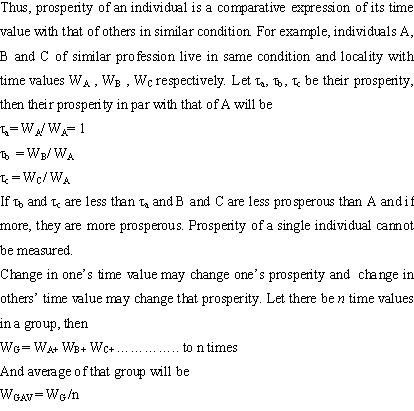
Groups may be professional, institutional, regional, political or of all sorts. Prosperities between two individuals of two different groups are affected by prosperity of corresponding group strata or levels. Average time value of the group individual rather than total time value represents the prosperity of the group. For example, in a group if the sum of all individual time values is WG and the average time value then
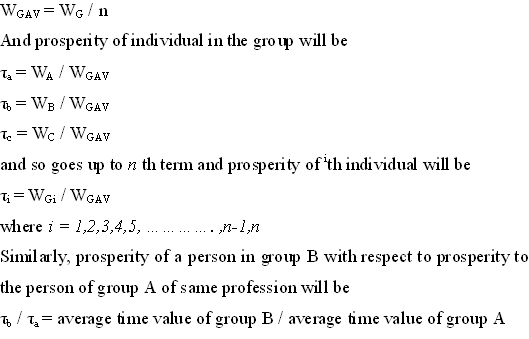
5. Prosperity Desire
When grass in one field dries out, animals go to other grazing fields looking for pasture. Early people did so too but later they learnt to raise their own grass on that very spot. They did so for better life, better than earlier and better than that of their neighbours. The first was for easier life and the second was a competitive instinct within their species. Not only they desired good and enough consumables but also liked to have those things best of all. While desire of better living was desire of self-development, desire of excellence among their own kinds was desire of prosperity or prosperity desire. While development desire was survival instinct, prosperity desire was a rat race within a society. Within the bound of allowed (sometime called ‘legal’) limits, such competition enthused a person for self-development. Accumulation of such individual efforts develops society. Human civilization is a total result of all individual human actions in the past. In conclusion, we can say that prosperity desire differentiates human beings from other animals and it is the driving force of human activity and civilization. If a human cannot act on prosperity desire, his activities will be limited to animal requirements such as food, water, merry-making and mating.
Human is neither a saint nor an angel. The fruit of his/her activity he wants to consume or dispose alone and on his/her own. Even if he/she cannot consume all what he/she has acquired, he/she will be ready to handover only a minuscule part of his gain. He/she would like to save it for his non-hay days. Human cares his/she own, animals do not. He/she has natural tendency not only of prosperity desire but also of saving or accumulation.
Prosperity gain of a person cannot be consumed by him/her alone, though he/she tries to. He/she has to share his/her gain with other fellow beings to maintain his prosperity. For example, if a person gains four pairs of shoes when he/she needs just one pair, he/she has to lend other three pairs to three other people. They will take those shoes only then, when they are able to pay for it. The former has to help the later one to raise prosperity at least so they could buy one pair each. Production by a person helps to increase his prosperity only if that production is distributed as consumables on his/her behalf among his/her fellow members and those fellow members will be able to consume it only if they are able to compensate him against that product. Prosperity desire provokes each one to raise his/her production and prosperity can be gained only if part of that product is consumed by other fellow members, who have applied the same process to raise their prosperity. Directly or indirectly, they barter their production or actually their labours or efforts and raise their prosperity. Better producer can have a chance to raise his prosperity more and worse producer too raises his/her prosperity but just a minuscule raise. Thus, time value of the whole community or society is raised due to the efforts of community members. Prosperity with respect to the past is raised too and society gets more developed. At the end of one process, starts another one and thus, run the spiral of civilization up and up and even the idlest one gets a small share of civilization. Development is another name of social uplift and it shows time value increment of society members in particular and that of the society in total. In development, social time value will increase with time but calamities may diminish social time value. Irrespective of social changes, prosperity of a person in that very society may rise or fall or standstill in both cases. For example, haves and haves-not existed in primitive society as they do today and more or less differences by their standard was their too..
6. Prosperity and Equality
‘All are equal to God.’ – says religion but God has never treated men equally. In reality no two things, even less two persons, are equal in all respects. A thing can be equal only to that very thing in all respects. That is a reality of nature. As inequality is expressed by different dimensions in different space, equality arranged in one space creates inequality immediately on others. Equality in all respects makes two things, ideas or expressions automatically one. Though absolute equality or equality in all respects cannot be maintained, people preached and promised partial equality all the time in history. Religion promised equality in heaven and invisible reality remained dream to all generations of human civilization. Jean Jacques Rousseau in 17th century raised voice for equality in politics and later in 19th century Karl Marx introduced another principle of financial equality.
Human being is dimensionally unequal in physique. Tall, short, thin, obese, bald, hairy, broad, narrow and others are his visible physique. Fast, slow, steady, clumsy, etc. are his physical characteristics or physical capabilities. They are nowhere equal to one person to another. There are mental capabilities too in form of logic, ideas, thought, etc. that dictate and control physical actions of human beings. If compared, no two persons are equal mentally as well. Even Siamese twins develop different capabilities physically and mentally. Amidst these unequal capabilities, we cannot and should not expect equal output from equal input on them. Thus, we can draw a conclusion that if people act in their full capacities, the outcomes or productions of their action in quantity and quality are never equal to one another.
More bizarre is consumption pattern. Non-producers like children, sick and old people may need more than adult producers. Investment on children is a saving for their parents or society and that on sick and old adults is liability of their past investment on their children or society. Consumption of adults is too never equal to one another. Thus, we conclude that neither input s(consumption) nor output s(production) of any two individuals are equal.
There are different options of input and output. The first one is equal input for equal output. Soldiers of one rank in a barrack get equal consumption and they are expected to have equal fighting capacity. The students of a class in a hostel are expected the same. Second option is equal input but an unequal output. Children may demand consumption equal to adults’ or even more but they never are asked for equal output. So may be the case among adults too. The third option is of unequal input and equal output. Two workers of one profession in two places may have different consumption possibility but they produce equal products. Or in a paid party, each individual pays equal amount though they consume differently.
The fourth option is unequal input and unequal output. As human beings are not equal, the consumption or input can never be equal and so cannot be equal to their production or output. Capitalism says - ‘They do what they can do and get what they produce’ and communists preach –. ‘They do what they can do and they get what they need’. Both of them accept unequal output for unequal input in one or other form. While capitalist allows the producer to save the positive extra output (output minus input), communists like to distribute that extra output among the less fortunate ones who have negative extra output for the sake of just distribution. In other words, while capitalism practices individual freedom, communism stresses on community benefit.
With guaranteed minimum requirements of livelihood, every individual in capitalist structure moved towards self-prosperity development and flourished. On the other hand, the protagonist of communist establishment drove hard the hungry enthusiastic mass towards euphoric dream of absolute equality and gained success to provide basic animal requirements of livelihood to all within the system. But hardly had a new generation been matured, the full belly generation started to get more from less. They opted negative prosperity desire i.e. to have the same time value for less work or to have the same prosperity from less toil. Lack of individual freedom and development of negative prosperity became the root cause of the fall of Soviet Union, the father nation of communist establishment. Snooping the pressure of negative prosperity, China, the biggest communist establishment in world, quickly shifted its position and allowed prosperity desire act positively and prospered very much within a quarter of a century.
20th century was a struggle between haves and haves-not or a struggle between more and less prosperous. It also showed that if not provided basic minimums, mass will revolt against the establishment and if positive prosperity is not allowed to work, negative prosperity desire starts automatically.
7. Poverty Line or Poverty Threshold
Who is poor? This term is undefined if there are no rich person and richness is undefined too without poverty definition. Poverty and richness, like two poles of a magnet, can exist only in pairs. So it became necessary to draw a line where these two terms meet and it is called poverty line or poverty threshold.
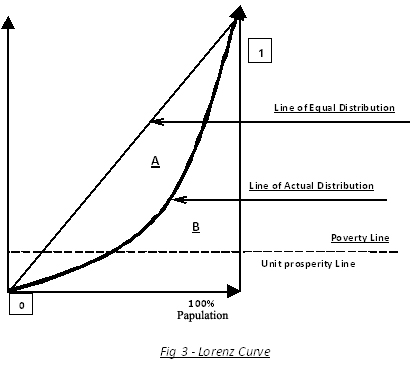
People having less time values below this threshold are assumed to be poor and above it rich. If the time value of a person at poverty line is taken as denominator and compared to other time values, prosperity at that poverty line can be taken as one i.e. above that poverty line it is more than one and below it, less than one.
Poverty is expressed in terms of time values called absolute poverty, whereas that expressed in relative terms, like prosperity, is called relative poverty. Change in time values of members of community in same proportion does not change their prosperity and relative poverty in the community but it changes the absolute prosperity.
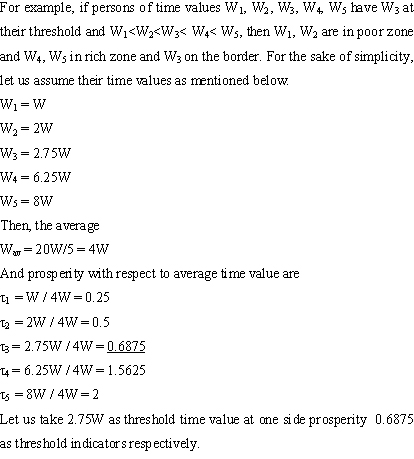
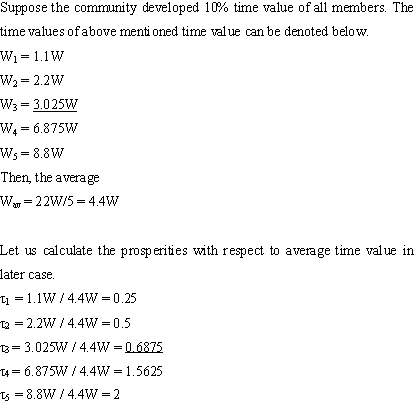
• Absolute poverty level is a fixed time value indicator of a person along time line.
• Relative poverty is a fixed prosperity indicator between individuals in community.
In the Lorenz Curve, the point where poverty line cuts the curve indicates the portion or percentage of population below that line. In that curve, lower the Gini’s coefficient, higher will be proportion of population below the poverty line. In the graph, wealth of whole community is taken as 1 and population in %. In the diagram, the area between Line of Equal Distribution and Lorenz Curve is noted as A and the rest as B.
Gini’s Coefficient, G = B/(A+B)
But, total wealth = 1
And so, triangle area A+B = ½
So, G = B/(A+B) = B/0.5
G = 2B
Prosperity is a proportional indicator of consumption of consumables between members of a society and all members will have equal prosperity if Gini's coefficient in Lorenz Curve equals to one on equal distribution of consumables.
8. Production
Production is a conversion process of raw material and/or service items to human consumables by human effort and the end outputs of such process are called products. Efforts of several components need to run such a process. Brain, one of the component which co-ordinates others component to run the process, is called management component. Capital component provides consumables to the process. Human skill used in the process is called labour.
Capital component may be a personal tycoon or public shareholders as in capitalist system or a state as in communist or socialist ruled state or may be a benevolent human society as hoped in communism or in Utopia. The management, of course, will be a group of subject-trained people selected and authorized by capital component. The labour component is a group of people selected as per requirement of the process and authorized by the management component. Absence of any one of these components collapses the production process.
9. Saving, Investment and Capital
In a group of equal distribution, the stingiest saves the most but it does not mean that he will spend that saved amount on later date. An entrepreneur will borrow from him, will run it as a capital and will return him that amount with some interest. In other words, saving is a stingy act; investment is a risky spending of that saving in form of capital. An entrepreneur miser may perform both of actions, if he desires, but that is rare.
But all these actions do not come from nothing. Desire for prosperity acts behind the scene. The miser stockpiles his saving not for nothing but to raise his prosperity status in his community and the entrepreneur does the same through production for profit. For example, a shoemaker A makes a pair of shoes every day, sells it, buys raw materials for another pair and the rest income he uses for his daily livelihood. At the end of the day he has nothing but the raw material for another one pair. As demand of his shoes is there, one good day, he borrows more money from a miser for raw materials for another pair of shoes to have a full day’s work for him. At the end of the day, he disposes both of the pairs, earns extra money returns back loan with some interest. Within some days he is able to have two pairs of shoes by himself without borrowing. As there is demand and his effort continues, he will be able to buy a sewing machine and hire an assistant. The assistant will learn to work and help him. At the end of a period, the master pays the junior, discounts all expenses and gains some profit. The entrepreneur goes on investing his profit for further gain to fulfill his never-ending desire of prosperity.
Karl Marx forwarded a principle of equality – ‘Give him what he needs and force him what he can do’ or ‘supply as per needs and work as per capacity.’ Communist Party of Soviet Union continued party authoritarian rule for three quarter of a century to achieve Marx’s dream of equality but could not reach beyond state capitalism and, at last, it itself got dissolved. Another giant nation, communist China, smelled the fiasco immediately and turned its economy towards prosperity competition. History and experience of different communist ruled countries concluded that definition of equality of classical communism works true until basic animal needs are not fulfilled. Prosperity desire works all the time. First, human tries to fulfill his animal needs and then, goes to its prosperity desire i.e. goes to increase his prosperity level. Also, change in prosperity of one individual member of a society brings change in social prosperity. Classical communism defined vice versa i.e. individual member should work to change the prosperity of the society and that change in society brings change in individual prosperity.
10. Time Line Prosperity and Development
Before the Second World War, a common mathematical calculator, equivalent to now available on footpath of under-developed countries, was a colossal machine beyond the dream of a common human even of a developed country. Thousands of such examples are available. It shows the increase of prosperity of the people as a whole along the time line. Such change is visible in food, in healthcare and in all sectors. Change in time value of an individual along the time line changes his prosperity relative to his past along the line and such change indicating the change of prosperity of an individual within the given duration is called Time Line or Vertical Prosperity.
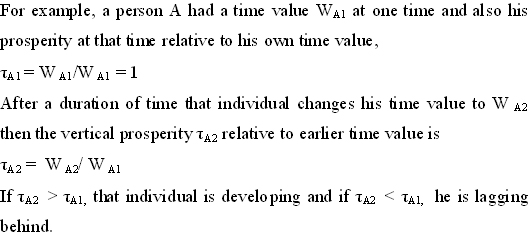
Time line prosperity indicates development of an individual or of a group or society or of a nation in time duration. So, it can be called development indicator. Development is not subject of single individual prosperity but accumulation of individual prosperities in a society or nation. Modern human world is so complex and related to each other that part of individual prosperity is automatically distributed to whole community in one form or other. Effect of change of prosperity goes from one individual to society, from society to nation and from a nation to the whole human community. Prosperity cannot work neglecting or discarding individual desire and neither or social prosperity can be changed group without changing individual prosperity. Flight of flock of geese is due to the flight of individual goose of the flock, not vice versa. Every goose is free to move as it likes towards common goal to move the flock in one. Likewise, each human being is free to act on his own to advance forward the human community towards a goal under certain rules. Desire for prosperity need individual freedom to act and ultimate net result of these actions is development of civilization.
11. Capital and Exploitation
Earlier, we found that saving turns to capital if it is invested to earn more saving by entrepreneurship. Money deposited in banks, though earns interest, is not a capital. Mere earning does not turn an amount to capital. Though raw materials and tools are essential to run capitalist enterprise, they are just accessories to human risk and labour. By means of accessories, venture and risk of an entrepreneur and labour of the workers turn saving into capital. If entrepreneur does not risk his capital, labour alone cannot run the enterprise; neither capitalist can run it without the labourers. Two human resources, human venture and labor turn a saving to capital. In a capitalist enterprise two desires of prosperity act at opposite directions. While the capitalist desires to have more production from the same amount of risk, the labor wants to have more wages for the same amount of labour. As no capitalist enterprise can exist without either of capital or labour, these contradiction desires are attached to each other like two poles of magnet always trying to get a neutral point. Before twentieth century, rights of labourers were not accepted and capitalist did what he liked in the enterprise. May 1 revolt of labourers started a change in mind of capitalist and labourer both. In mid-nineteenth century, Karl Marx forwarded a theory that accepted the right of labourers, and not of the capitalists, within the enterprises. The communist government, based on Marx’s principle, in Soviet Union practiced non-individual capitalist enterprise to create an non-exploitation society but could not go beyond state capitalism where the state administrators had to act the role of pseudo-capitalists without any personal desire, if they acted sincerely and as corrupt official, if they followed unholy desire to loot the enterprise. On the other side, while an un-sincere labor avoided the work in one pretext or other and the capitalist was absent to cajole him, a sincere labour saw no chance of prosperity in work. Both the parties had neither responsibility nor feeling of ownership towards the enterprise. Even in normal and sincere practice, pseudo-ownership of enterprise through government by labourers deprived them the right of desire of individual prosperity increment and the administrators had a pseudo right without any right to own it. As the prosperity desire stops nowhere, the administrators started corrupt practices to gain some thing and the labourers idled and cheated their own work time to gain negative prosperity. In the mean time, the westerners expanded ownership of their capitalist system distributing capital shares as far as possible up to the common people and labourers and providing trade union rights to the labourers to express their grievances through organizations and negotiate better labour conditions through them.
Now, let us discuss this term ‘exploitation’. The English word ‘exploit’ has two meanings, ‘use, work or develop natural resources of a country’ in good sense and ‘use selfishly or for one’s own profit’ in negative sense and exploitation too bears both of the senses. In an industrial enterprise, both the capital and labour are essential. Capital must gain something to work further. That very saving works as a capital in further development. Accumulation of capital is not possible without exploitation of resources and labor. If an industry distributes all what it acquires from a production cycle among the laborers and gains nothing, the industry will have nothing to accumulate and use as capital for further development. So, like it or dislike, exploitation is essential to continue industrial development further. Just rein capitalist activity not to let it run amok as nineteenth century capitalists in Europe and North America did and abolition of capitalist activity will stagnate industrial development as communist states experienced. Controlled exploitation of resources and labour and balanced distribution of gain between production components will provide incentives to capital and manage component for further industrial ventures and a just distribution of the gain to the labour component.
Exploitation, if not used in negative sense, is a tool of industrial development. Absence of exploitation dismantles the cycle of industrial production development and human beings will have to be satisfied with what they have now.